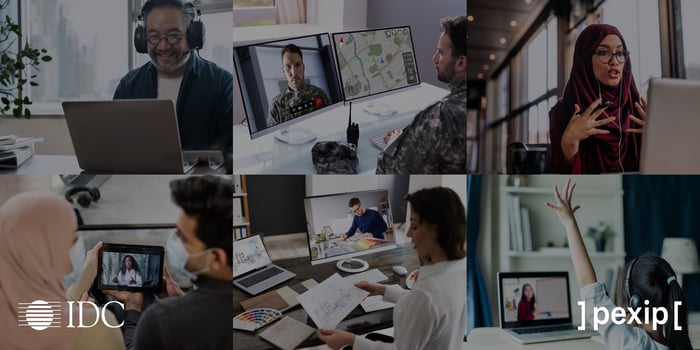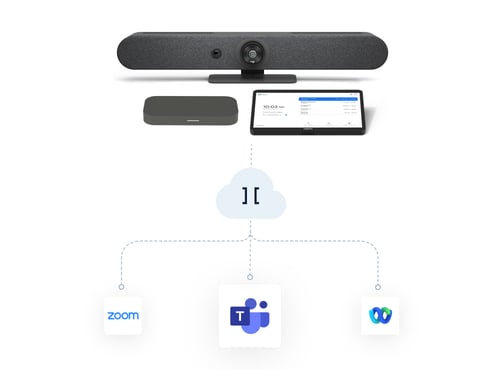The age of video has arrived. However, the biggest growth opportunities for video are still to come with experiences that can enhance customer services in ways we’ve never seen before, says CRO Åsmund Fodstad.
For years, we’ve been saying that video communications would soon take off, that we were on the cusp of a transformation. With the disruption and accelerated innovation we’ve seen this decade, we can now say that the age of video has arrived. Everyone is using it.
Recent research commissioned by Pexip shows how much businesses have come to rely on video. IDC’s report, ‘Embracing the new video economy’, shows video had a global market growth of 46.8% during 2020.
That is easy to imagine.
When the first Covid outbreaks happened, businesses had to make a rapid shift to virtual meetings. Before then, most meetings had been over audio, with speaker phones set up in board rooms or conference lines to dial into. But the need for connection meant video exploded during the early pandemic. In the first six months of 2020, the growth in collaborative application usage – including video – outpaced growth in the prior five years.
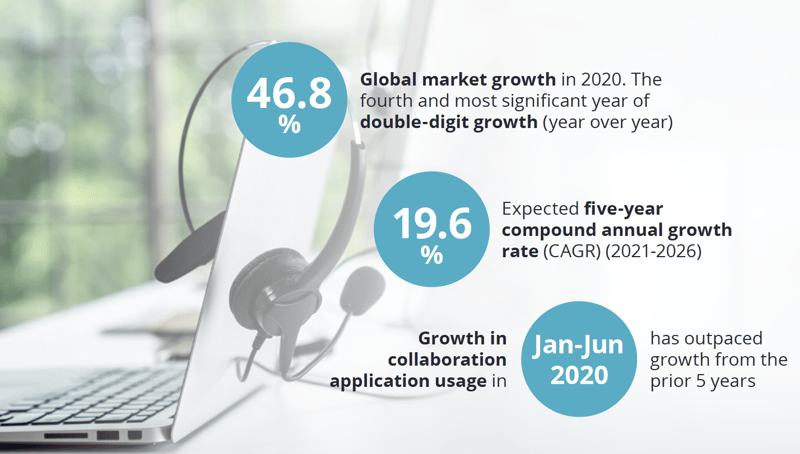
The technology was enhanced to meet an explosion of needs and new users. Video conferencing was mostly about meeting and seeing people – firstly replacing travel, which was on hold, and then as a complement to it. Video became a tool for communicating directly with other people, as the phone had before it. That early growth was driven by necessity and convenience.
What is more interesting is IDC’s predicted growth. Its report shows an expected 19.6% compound growth rate between 2021 and 2026 – long after the initial burst of adoption has passed.
Beyond video conferencing; what is the future of video communication?
Video has arrived. Now it’s evolving.
It’s not that more people will start using video conferencing. That market has reached maximum saturation – or is close to it. We can travel again, and yet people are still using video multiple times a day as part of their normal interaction with work and family. Users embrace collaboration tools in general:
- 87% say they feel more connected
- 85% see improved productivity
- 83% say their customers and partners want direct collaboration
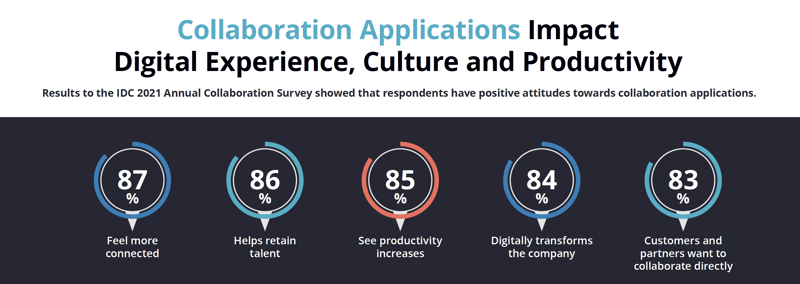
Increasingly, video conference providers are now looking at ways to improve user experience – for example, creating more interesting backgrounds or filters, increasing user features such as raise hand and other large group management features, or expanding to virtual or augmented reality.
So, video for meetings continues to evolve. However, increased levels of comfort with video and advancements in technology – including Artificial Intelligence (AI) and Machine Learning (ML) are driving an acceleration of video use - beyond the office and enterprise.
The biggest growth opportunities for video come from evolving experiences that can enhance customer experience in ways we’ve never seen before.
IDC predicts this growth will be especially focused on a few key industries: health management, customer identification concierge services, as well as citizen services access and support.
Embracing the New Video Economy
Read this IDC guide to understand how organizations are closing the distance between physical and digital interactions for better customer and citizen engagements.
Embracing new video services in Justice, Healthcare & Government – APAC snapshot
Used creatively, video becomes a way to provide better and more innovative services for customers, improve efficiencies, save money, and lead the way in innovation.
The embedding of video in business processes is forecast to grow significantly across Asia-Pacific (AP) in the post-COVID world.
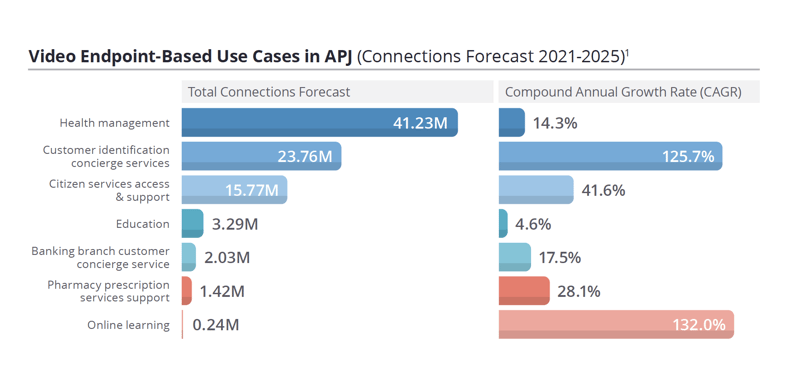
IDC's IoT Access and Traffic Model 2H 2021 projects that across Asia-Pacific and Japan (APJ), health-focused use cases account for 41 million connections by 2025 with a CAGR of 14% from 2021-2025. Use cases like remote consultation account for most events in this area as COVID-19 has continuing impact on the execution of healthcare.
But we also see continuing growth in use of video for customer engagement, with 24 million connections by 2025 and rapid growth of 125% CAGR. Access and support to citizen services will drive this further with an anticipated 16 million connections arising from customer engagement in the public sector.
How video supports critical retail, government, and healthcare industries
At Pexip, we’re working with organizations beyond their enterprise or internal office environment. Our mission is to work with customers to achieve theirs – delivering purpose-built video communication to add value at multiple touchpoints, across many industries, and for every kind of interaction.
It’s central to our strategy for becoming #1 in key vertical markets such as justice, retail, government and finance.
Let’s look at how video is already being integrated into new video service models.
Government-2-Citizen services: The Federal Employment Agency (BA) in Germany, employs about 100,000 people. When Covid hit, BA needed a secure and highly scalable video communication solution that would keep day-to-day citizen consultations up and running. BA now offers a 3 click approach in delivering citizen services with video with an impressive reach – already delivering 200,000+ consults over video, offering job placement, career counselling as well as supporting critical services such as family allowances and unemployment benefit.
Virtual courts: Globally, 1.5 billion people worldwide have justice problems they can't solve, and the pandemic has created even more obstacles to a fair hearing. Many court systems have adopted video to move hearings forward. Video has helped to break down these barriers and clear backlog, connecting judges, lawyers, witnesses and defendants on an accessible and secure video platform.
Healthcare: Doctors, nurses and specialists use virtual healthcare continued to see patients at record levels. Over 13 million Australians have access to video telehealth and at least 50% of US virtual healthcare visits are on a video platform. We’re seeing examples of hospitals in Norway, integrating video into ambulances to facilitate remote consultation support for paramedics. Healthcare workers changed their operations and policies to facilitate end-of-life communications in ICU wards when families and loved ones are unable to visit those closest to them who are seriously ill.
Making everyday life easier – the future of retail
Video can make things easier for consumers and their everyday lives, as well. IKEA is a great example of a business that’s pivoted during Covid who have fully created digitized experiences for customers – using video to view lay outs and design kitchens without ever stepping foot in store.
We’re also seeing other retail concepts being explored as well. Imagine you step into a shopping mall and see a stunning [insert dream car of your choice!] that you might be interested in buying. Rather than talking to a salesperson who can give you a glossy brochure and a contact number, instead there’s a video kiosk. In an instant, you can connect to an expert who will help you learn more about the car, using video communication not only to talk directly to you but to share footage, put together a custom build on the spot, give live availability information and so on.
-min.png?width=800&height=397&name=Future-of-retail-arranging-a-test-drive(EDITED)-min.png)
If you have time, that expert connects you with another expert. Now you’re engaging with one of the mechanics in their factory, and they are demonstrating in real time how the new electric motor works. From there, you connect with someone from the R&D team, who explains what the next generation of connectivity will look like, showing you features that integrate with your lifestyle to make this car the perfect choice for you.
The whole time, you have been standing in a shopping mall in your city, anywhere in the world. Now, you’re booking a test drive – and you can’t wait.
From the business’s point of view, there are many actions they can follow up with during this process. Your details can be entered into their CRM system. They can take what they have learned from your interaction with the video kiosk and use that data to provide a better service for you. They can connect you with finance and insurance.
You have a better customer experience. The car manufacturer has better data to help you and grow their business. And it all happened over video.
Powering a new video economy
When we started Pexip, our dream was that the world would truly adopt video. That happened during Covid. So now we have a new dream; discovering new ways of using video in support of organizations and their customers, citizens or communities by making it valuable within any business workflow.
There will be a completely new economy around it.
Not because we can’t meet due to Covid or travel restrictions, but because video adds so much extra value to the transaction. Beyond the enterprise, we won’t need to use video to communicate – we’ll want to.
Embracing the New Video Economy
Read this IDC guide to understand how organizations are closing the distance between physical and digital interactions for better customer and citizen engagements.
- Financial services
- Enterprise
- Healthcare
- Judicial
- Government
- Retail
- Digital transformation
- Personalize customer engagement

